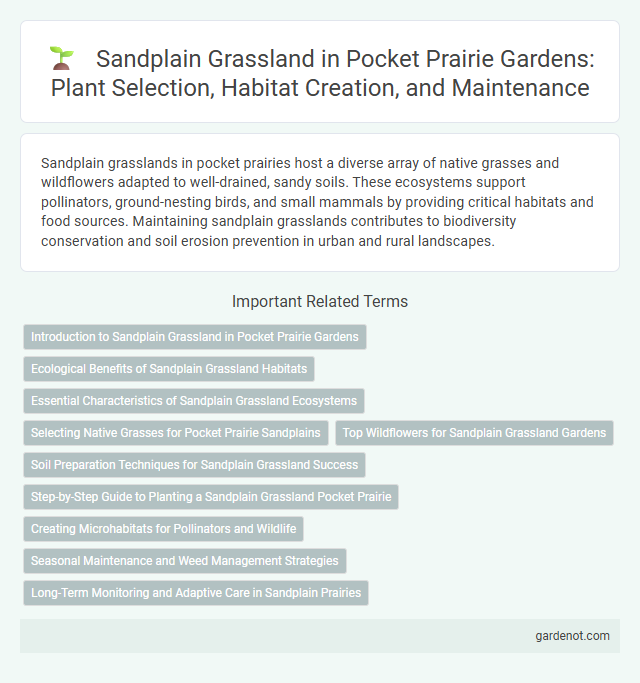Sandplain grasslands in pocket prairies host a diverse array of native grasses and wildflowers adapted to well-drained, sandy soils. These ecosystems support pollinators, ground-nesting birds, and small mammals by providing critical habitats and food sources. Maintaining sandplain grasslands contributes to biodiversity conservation and soil erosion prevention in urban and rural landscapes.
Introduction to Sandplain Grassland in Pocket Prairie Gardens
Sandplain grasslands in Pocket Prairie Gardens feature a unique ecosystem dominated by native grasses such as little bluestem (Schizachyrium scoparium) and Pennsylvania sedge (Carex pensylvanica), providing critical habitat for pollinators and grassland birds. These habitats support biodiversity by hosting rare wildflowers, including wild lupine (Lupinus perennis), essential for monarch butterfly larvae. Soil composition characterized by sandy, well-drained substrates influences plant species diversity and resilience in this grassland type.
Ecological Benefits of Sandplain Grassland Habitats
Sandplain grassland habitats support high biodiversity by providing critical nesting and foraging grounds for native pollinators and grassland birds. Their deep-rooted native grasses enhance soil stability and water infiltration, reducing erosion and promoting groundwater recharge. These ecosystems also act as natural carbon sinks, sequestering atmospheric carbon and mitigating climate change impacts.
Essential Characteristics of Sandplain Grassland Ecosystems
Sandplain grassland ecosystems are characterized by well-drained, sandy soils that support a diverse array of drought-tolerant grasses, wildflowers, and low shrubs. These ecosystems exhibit high biodiversity with many endemic and rare plant species adapted to nutrient-poor, acidic conditions. Fire regimes and periodic disturbances play a crucial role in maintaining species composition and preventing woody plant encroachment in sandplain grasslands.
Selecting Native Grasses for Pocket Prairie Sandplains
Selecting native grasses such as little bluestem (Schizachyrium scoparium) and big bluestem (Andropogon gerardii) is essential for establishing a resilient pocket prairie on sandplain ecosystems. These warm-season grasses are adapted to sandy, nutrient-poor soils, providing erosion control and habitat for pollinators and upland birds. Incorporating species diversity with side-oats grama (Bouteloua curtipendula) and Indian grass (Sorghastrum nutans) further enhances ecological stability and supports native wildlife in sandplain pocket prairies.
Top Wildflowers for Sandplain Grassland Gardens
Top wildflowers for sandplain grassland gardens thrive in well-drained, nutrient-poor soils and include iconic species such as Butterfly Weed (Asclepias tuberosa), which attracts pollinators with its vibrant orange blooms, and Wild Lupine (Lupinus perennis), a nitrogen-fixing plant crucial for soil health. Other notable species are Purple Coneflower (Echinacea purpurea) and New England Aster (Symphyotrichum novae-angliae), both supporting diverse insect populations while adding seasonal color. Incorporating these native wildflowers promotes biodiversity, enhances habitat value, and supports the ecological integrity of pocket prairie restorations.
Soil Preparation Techniques for Sandplain Grassland Success
Effective soil preparation techniques for Sandplain grassland restoration involve careful removal of invasive species and minimal soil disturbance to preserve native seed banks. Techniques such as prescribed burning and targeted herbicide application enhance soil nutrient cycling and create favorable conditions for native grasses and wildflowers. Incorporating light tillage followed by seeding with native species adapted to sandy, well-drained soils promotes successful establishment and long-term ecosystem resilience.
Step-by-Step Guide to Planting a Sandplain Grassland Pocket Prairie
Selecting native species such as little bluestem, switchgrass, and wild lupine ensures a resilient sandplain grassland pocket prairie. Prepare the soil by clearing invasive plants and lightly tilling to promote seed-to-soil contact, vital for germination. Sow seeds evenly in late fall or early spring and maintain minimal watering during establishment to mimic natural conditions and optimize growth.
Creating Microhabitats for Pollinators and Wildlife
Sandplain grasslands support diverse microhabitats by providing varying plant heights and native flowering species critical for pollinators like bees and butterflies. Incorporating pocket prairies with native grasses and wildflowers enhances shelter and food resources for wildlife, promoting biodiversity. These microhabitats improve ecological resilience by creating niches that sustain pollinator populations and small wildlife throughout seasonal changes.
Seasonal Maintenance and Weed Management Strategies
Seasonal maintenance of Sandplain grassland in pocket prairies involves targeted mowing and prescribed burns during late winter to early spring, promoting native grass growth and inhibiting invasive species. Effective weed management combines manual removal with selective herbicide application to control invasive plants such as spotted knapweed and Canada thistle, preserving biodiversity. Regular monitoring throughout the growing season ensures early detection and swift treatment of emerging weed populations, maintaining ecological balance.
Long-Term Monitoring and Adaptive Care in Sandplain Prairies
Long-term monitoring in sandplain grasslands tracks species composition, soil health, and invasive species trends to inform adaptive care strategies. High-resolution data enables targeted interventions such as controlled burns and selective mowing to maintain native biodiversity and ecosystem resilience. Continuous assessment ensures restoration efforts effectively support rare plant populations and respond to changing environmental conditions.
Sandplain grassland Infographic

 gardenot.com
gardenot.com